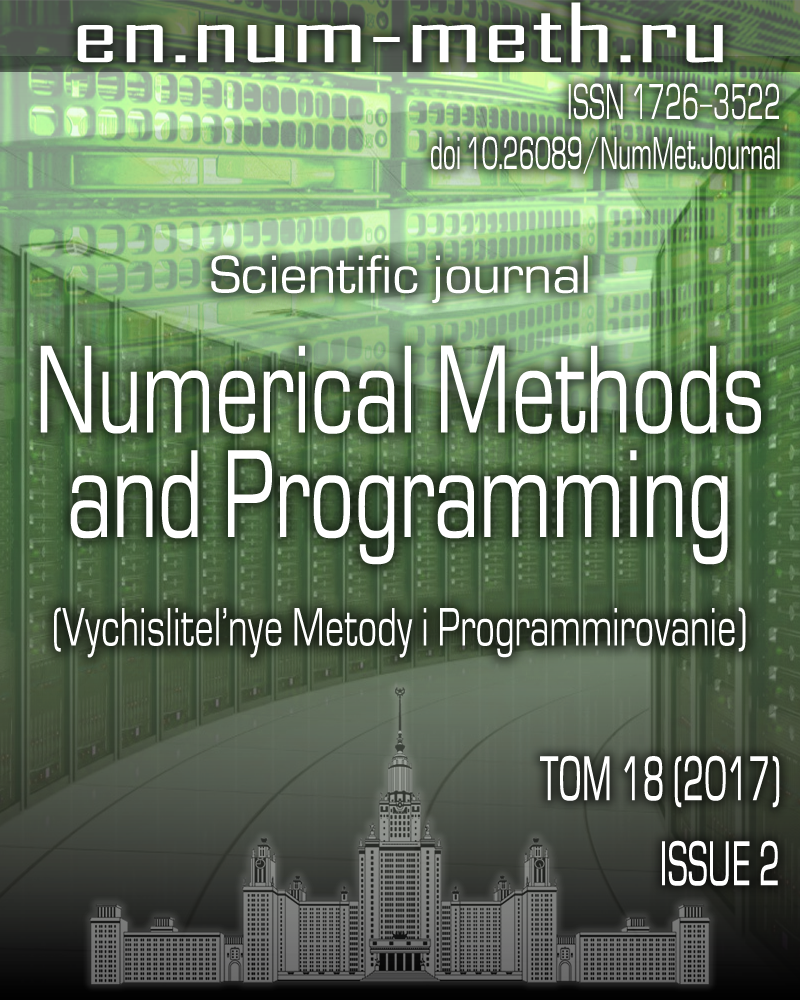DOI: https://doi.org/10.26089/NumMet.v18r210
A new tomography method in the presence of an opaque object
Keywords:
two-dimensional tomography
opaque inclusion
Cavalieri condition
Abstract
A new tomography method for a two-dimensional object containing an opaque inclusion is developed. For the estimation of unknown data in the opaque object’s shadow, the system of linear algebraic equations derived from the representation of projections of moments by homogeneous polynomials is solved. The numerical results show that the method has a number of advantages over alternative approaches.
Published
2017-03-27
Issue
Section
Section 1. Numerical methods and applications
References
- Ch. M. Ziegler, M. Franetzki, T. Denig, et al., “Digital Tomosynthesis - Experiences with a New Imaging Device for the Dental Field,” Clin. Oral Invest. 7 (1), 41-45 (2003).
- V. Van der Linden, E. Van de Casteele, M. S. Thomas, et al., “Analysis of Micro Computed Tomography Images; A Look Inside Historic Enamelled Metal Objects,” Appl. Phys. A 98 (2), 385-392 (2010).
- V. V. Pikalov and N. G. Preobrazhenskii, Reconstructive Tomography in Gas Dynamics and Plasma Physics (Nauka, Novosibirsk, 1987) [in Russian].
- A. V. Likhachev and V. V. Pikalov, “Three-Dimensional Tomography in Gas Flow Diagnostics in the Presence of an Opaque Body,” Zh. Prikl. Mekh. Tekh. Fiz. 39 (1), 174-180 (1998) [J. Appl. Mech. Tech. Phys. 39 (1), 152-157 (1998)].
- G. T. Herman, Image Reconstruction from Projections. The Fundamentals of Computerized Tomography (Academic, New York, 1980; Mir, Moscow, 1983).
- F. Natterer, The Mathematics of Computerized Tomography (Wiley, New York, 1986; Mir, Moscow, 1990).
- G. H. Glover and N. J. Pelc, “An Algorithm for the Reduction of Metal Clip Artifacts in CT Reconstructions,” Med. Phys. 8 (6), 799-807 (1981).
- B. P. Medoff, W. R. Brody, M. Nassi, and A. Macovski, “Iterative Convolution Backprojection Algorithms for Image Reconstruction from Limited Data,” J. Opt. Soc. Amer. 73 (11), 1493-1500 (1983).
- W. A. Kalender, R. Hebel, and J. Ebersberger, “Reduction of CT Artifacts Caused by Metallic Implants,” Radiology 164 (2), 576-577 (1987).
- G. Wang, D. L. Snyder, J. A. O’Sullivan, and M. W. Vannier, “Iterative Deblurring for CT Metal Artifact Reduction,” IEEE Trans. Med. Imag. 15 (5), 657-664 (1996).
- D. D. Robertson, J. Yuan, G. Wang, and M. W. Vannier, “Total Hip Prosthesis Metal-Artifact Suppression Using Iterative Deblurring Reconstruction,” J. Comput. Assist. Tomogr. 21 (2), 293-298 (1997).
- S. Zhao, D. D. Robertson, G. Wang, et al., “X-Ray CT Metal Artifact Reduction Using Wavelets: An Application for Imaging Total Hip Prostheses,” IEEE Trans. Med. Imag. 19 (12), 1238-1247 (2000).
- J. L. Prince and A. S. Willsky, “Constrained Sinogram Restoration for Limited-Angle Tomography,” Opt. Eng. 29 (5), 535-544 (1990).
- N. V. Vazhenceva and A. V. Likhachov, “Comparison of Limited-Angle Tomography Algorithms Based on the Cavalieri Condition,” Avtometriya 48 (6), 35-45 (2012) [Optoelectron., Instrum. Data Process. 48 (6), 565-573 (2012)].
- A. V. Likhachov, “Use of the Cavalieri Conditions in Region-of-Interest Tomography,” Avtometriya 51 (4), 53-61 (2015) [Optoelectron., Instrum. Data Process. 51 (4), 364-371 (2015)].
- S. Helgason, The Radon Transform (Birkh854user, Basel, 1980; Mir, Moscow, 1983).
- I. M. Gelfand, S. G. Gindikin, and M. I. Graev, Selected Problems of Integral Geometry (Dobrosvet, Moscow, 2000) [in Russian].
License
Copyright (c) 2017 Вычислительные методы и программирование

This work is licensed under a Creative Commons Attribution 4.0 International License.


